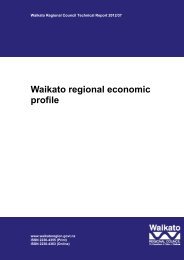Spatial distribution and seasonal variation in Undaria pinnatifida ...
Spatial distribution and seasonal variation in Undaria pinnatifida ...
Spatial distribution and seasonal variation in Undaria pinnatifida ...
Create successful ePaper yourself
Turn your PDF publications into a flip-book with our unique Google optimized e-Paper software.
zone are 50-100plants mˉ² or less (Brown <strong>and</strong> Lamare, 1994; Brown, 1999; S<strong>in</strong>ner et al, 2000). This is consistent withdata from other populations outside its native range (Castric-Fey et al, 1993; Campbell <strong>and</strong> Burridge, 1998).Seawater nutrient data showed a higher availability of nitrogen dur<strong>in</strong>g the w<strong>in</strong>ter months. Nitrogen levels <strong>in</strong> sea water areknown to be lowest <strong>in</strong> the summer <strong>and</strong> highest <strong>in</strong> w<strong>in</strong>ter with<strong>in</strong> temperate coastal waters <strong>and</strong> ammonia <strong>and</strong> phosphate arepresent at consistent concentrations throughout the year (Dean <strong>and</strong> Hurd, 2007) as was observed, although ammonialevels were highly variable over the summer months (from November onwards).The availability of seawater nutrients is one of the primary factors regulat<strong>in</strong>g the growth, reproduction <strong>and</strong> biochemistry ofseaweeds, with evidence suggest<strong>in</strong>g that N, P <strong>and</strong> Fe can limit the growth of seaweeds (Lobban <strong>and</strong> Wynne, 1981).<strong>Undaria</strong> crop yield <strong>in</strong> Asia is commonly <strong>in</strong>creased through the application of nitrogen fertilisers (Dean, 1998). Seawaternutrient levels from temporal monitor<strong>in</strong>g sites showed overall seawater nutrient concentrations were similar between theCorom<strong>and</strong>el <strong>and</strong> Westhaven Mar<strong>in</strong>a monitor<strong>in</strong>g sites, this <strong>in</strong>dicates the mussel farm does not <strong>in</strong>fluence these seawaternutrient levels at the Corom<strong>and</strong>el site. These results agree with those of an <strong>in</strong>vestigation by Duder (2009) which found thatmussel aquaculture around Great Barrier Isl<strong>and</strong> did not raise seawater nutrient levels or enhance the growth of <strong>Undaria</strong>.5.3. Other <strong>in</strong>vasive speciesStyela clava was found on all the mussel farms surveyed <strong>and</strong> Codium fragile ssp. tomentosoides was present on twentyeight out of the thirty one farms surveyed. Both these species are known for be<strong>in</strong>g <strong>in</strong>troduced <strong>and</strong> spread via shellfishaquaculture (Pagad, 2012). They also have the potential to impact negatively upon both the mussel farm<strong>in</strong>g <strong>in</strong>dustrythrough heavy foul<strong>in</strong>g <strong>and</strong> on native benthic communities by outcompet<strong>in</strong>g native species for resources. Charybdisjaponica, the Asian paddle crab, was found at two coastal sites. This species could impact negatively upon native benthiccommunities though competition for space <strong>and</strong> resources with native crab species. Charybdis japonica is also known totransmit disease <strong>and</strong> prey on native shellfish, which is a potential threat to local fisheries <strong>and</strong> shellfish (Pagad, 2012).5.4. Implications <strong>and</strong> considerationsAll the mussel farm sites surveyed had similar environmental conditions <strong>and</strong> all provide suitable habitat for the colonisation<strong>and</strong> growth of <strong>Undaria</strong>. The open structures supply shallow, well illum<strong>in</strong>ated substrate free from graz<strong>in</strong>g pressures <strong>and</strong>competitive algal species. The farms are positioned <strong>in</strong> areas of good water flow <strong>and</strong> with sufficient nutrients to provide forthe rapid growth <strong>and</strong> health of mussels for commercial harvest<strong>in</strong>g, sal<strong>in</strong>ity read<strong>in</strong>gs taken dur<strong>in</strong>g the spatial <strong>and</strong> thetemporal surveys showed little freshwater <strong>in</strong>fluence over time or between sites. These conditions are consistent with ideal<strong>Undaria</strong> habitat (Verlaque, 2007). In general the longer the mussel ropes have been <strong>in</strong> the water grow<strong>in</strong>g the mussels thegreater potential there is for <strong>Undaria</strong> to grow on the l<strong>in</strong>es. The dense populations of large <strong>Undaria</strong> plants seen at theWBMFZ <strong>and</strong> on the four other heavily <strong>in</strong>fested farms on the western Corom<strong>and</strong>el will have strong impacts on lightavailability, nutrient cycl<strong>in</strong>g <strong>and</strong> food availability for the mussels be<strong>in</strong>g grown on these farms (Cecere et al., 2000; Henkel<strong>and</strong> Hofmann, 2008).The dense population seen at the WBMFZ, where heavy <strong>in</strong>festations <strong>in</strong>cluded the presence of all life stages of <strong>Undaria</strong>plants on both site visits, ensures a constant <strong>and</strong> immense supply of spores at this site. This high propagule pressure islikely to perpetuate the extensive population at this site despite differ<strong>in</strong>g stages of mussel growth <strong>and</strong> l<strong>in</strong>e/float rotation at<strong>in</strong>dividual farms with<strong>in</strong> the MFZ. For smaller mussel farms, clean<strong>in</strong>g of the floats <strong>and</strong> other <strong>in</strong>frastructure does appear toreduce the prevalence <strong>and</strong> potential effects of <strong>Undaria</strong>, as well as other <strong>in</strong>vasive species at these sites.<strong>Undaria</strong> was found at six coastal sites. Plants were found with<strong>in</strong> one of the 50m transects at each of these sites. Sampl<strong>in</strong>gwas concentrated on the shallow-subtidal marg<strong>in</strong> of the reef, typically just below the low-tide mark. Much of the reefadjacent to the farms <strong>in</strong> the western Corom<strong>and</strong>el is of a similar physical composition, relatively shallow, with a s<strong>and</strong>-reefborder at depths of less than 5 m <strong>and</strong> a limited offshore extent of 15-30 m. Although many of the sites surveyed weresimilar <strong>in</strong> nature it was not possible to easily predict the presence or absence of <strong>Undaria</strong>. The factors <strong>in</strong>volved <strong>in</strong> theestablishment of <strong>Undaria</strong> populations at coastal sites are likely to be complex <strong>and</strong> site specific (S<strong>in</strong>ner et al, 2000).Graz<strong>in</strong>g by urch<strong>in</strong>s, fish <strong>and</strong> molluscs, <strong>and</strong> <strong>in</strong>teractions with other macroalgae are potential <strong>in</strong>fluences which are difficult toquantify but have been shown to be important <strong>in</strong> determ<strong>in</strong><strong>in</strong>g the colonisation success <strong>and</strong> impact of <strong>Undaria</strong> (Valent<strong>in</strong>e26
















